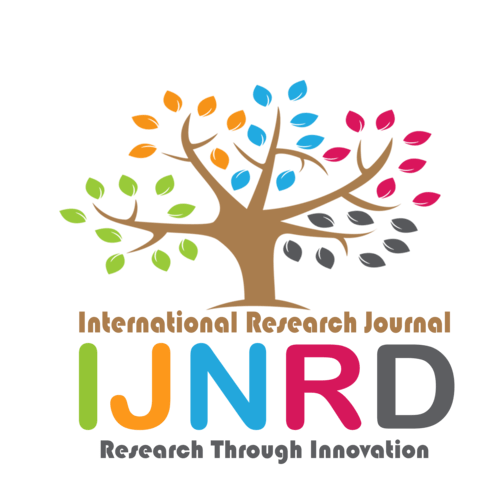|
|||||||||||||||

|
INTERNATIONAL JOURNAL OF NOVEL RESEARCH AND DEVELOPMENT International Peer Reviewed & Refereed Journals, Open Access Journal ISSN Approved Journal No: 2456-4184 | Impact factor: 8.76 | ESTD Year: 2016 Scholarly open access journals, Peer-reviewed, and Refereed Journals, Impact factor 8.76 (Calculate by google scholar and Semantic Scholar | AI-Powered Research Tool) , Multidisciplinary, Monthly, Indexing in all major database & Metadata, Citation Generator, Digital Object Identifier(DOI) |
||||||||||||||
Issue: April 2024
Volume 9 | Issue 4
Review Result and Publication of Paper within : 2-3 days
Click Here For more DetailsFor Authors
Forms / Download
Published Issue Details
Editorial Board
Other IMP Links
Facts & Figure
Impact Factor : 8.76
Issue per Year : 12
Volume Published : 9
Issue Published : 95
Article Submitted :
Article Published :
Total Authors :
Total Reviewer :
Total Countries :
Indexing Partner
Join RMS/Earn 300
Licence
This work is licensed under a Creative Commons Attribution-NonCommercial 4.0 International License







|
Published Paper Details
|
|
| Paper Title: | ''TEACHER'S CAPABILITIES IN USING MODULAR DISTANCE LEARNING IN SCIENCE DURING COVID-19 PANDEMIC'' |
| Authors Name: | MYLES JANINE E. CARABIT |
| Download E-Certificate: | Download |
| Author Reg. ID: |
IJNRD_186991
|
| Published Paper Id: | IJNRDTH00016 |
| Published In: | Volume 8 Issue 2, February-2023 |
| DOI: | |
| Abstract: | This study aimed to determine the teachers’ capabilities in using modular distance in science during COVID-19 pandemic. Specifically, folds were answered: the professional background of the Science teachers in San Andres District and San Narciso District in terms of: Highest educational attainment, Length of service, Trainings and seminars attended, Number of years in teaching science; the capabilities of the Science teachers in using modular distance learning terms of: Instructional Capability, Technological Capability, Technical Capability, Management Capability and Logistical capability; the significant difference between the two groups of respondents on teachers’ capabilities in using modular distance learning along the different aspects; The significant difference in the teachers’ capabilities in using modular distance learning due to their professional background; and the virtual training design (webinar) that can be formulated based from the findings of the study. The descriptive-evaluative- inferential methods of research was used in determining the teacher’s capabilities in using modular distance in science during COVID-19 pandemic. A researcher made questionnaire was used in the data gathering. Total enumeration of Science teachers and school heads was used in selecting the respondents of the study. There were a total of 39 respondents of the study from San Andres and San Narciso District. The statistical tools used were the frequency count, percentage, weighted mean, rank order, Kendall Coefficient of Concordance W, and its corresponding Chi-square test. Findings 1. The Professional Background of the Science Teachers in San Andres District and San Narciso District in terms of highest educational attainment, length of service, trainings and seminars attended, and number of years in teaching Science. 1.1. In terms of highest educational attainment, 41% of the Science teachers are Bachelor’s Degree graduates; 33% have Master’s Degree units and 8% are Master’s Degree Graduates. 1.2. In terms of length of service, 46% of teachers are 1-5 years of service; 28% are in 6-10 years of service; 5% are in 11-15 years of service; and 3% are in 16-20 years of service. 1.3. In terms of trainings and seminars in Science, 54% of the teachers are able to participate in 1-5 seminars in Science; 21 % are able to participate in 6-10 seminars; 5 % are able to participate in 11-15 seminars and 3% are able to participate in 16-20 seminars. 1.4. In terms of number of years in teaching Science, 54% of the teachers are teaching Science for 1-5 years, 21% are teaching for 6-10 years, 5% have been teaching for 11-15 years, 3% are teaching for 16-20 years. 2. The Capabilities of the Science Teachers in Using Modular Distance Learning are assessed in terms of in terms of instructional capability, technological capability, technical capability, management capability and logistical capability. 2.1. Instructional capability earns an overall average of 3.84 and is verbally rated as moderately evident. The indicators under instructional capability are all rated as moderately evident are respectively: delivers learning objectives and contents that connect to higher concepts across content areas, 3.92; uses fair, transparent, and equitable assessment for all students, 3.90; provides learning experiences that are applicable to real-life situations. 3.85; provides ongoing descriptive feedback that is clear, specific, meaningful, and timely to support improved learning and achievement, 3.79; presents lessons at a pace that allows for reflection and review, 3.77; sets clearly defined objectives which are realistic, attainable and measurable, 3.77; includes effective performance tasks that require higher-order thinking, inquiry to construct knowledge and connections across subject areas, 3.72; plans ahead systematically organized learning opportunities and activities, 3.69; chooses assessment tools that are ongoing, varied in nature, and administered over a period of time to provide multiple opportunities for students to demonstrate the full range of their learning, 3.62; and develops students’ self-assessment skills to enable them to assess their own learning, set specific goals, and plan next steps for their learning, 3.59. 2.2. Technological Capability gets an overall average of 3.13 and is verbally rated as fairly evident. Three indicators fall under moderately evident. These are: : performs important tasks regarding data encoding using Microsoft Office and Excel, 3.77; creates presentations using Microsoft Power Point, 3.72; and participates in capability building activities to become equipped in utilizing various communication platforms, 3.72. Next, five are rated as fairly evident: devises audio, video presentations and other forms of media presentations as supplementary teaching and learning materials, 3.26; independently uses technological platforms being introduced by the Department of Education in teaching and monitoring learners, 3.21; has enough communication resources to maintain constant communication and feedback with parents, learners and colleagues, 3.18; skillful with the latest innovations and uses of technology in education, 3.08; and utilizes Office 365, DepEd Commons, DepEd Email and other DepEd prescribed online platform requirements, 2.95. Lastly, these two falls under evident: owns a personal internet subscription with stable connectivity that is essential for teaching and communication, 2.28; and has stable network provider signal (Smart, Sun Cellular, Globe, TNT and TM) essential for teaching and communication, 2.13. 2.3. Technical Capability earns an average of 3.65 and is verbally rated as moderately evident. Nine indicators belong to moderately evident, these are: aware on the basic roles and responsibilities of the government sector, teachers, learners and parents in the implementation of modular distance learning, 3.95; understands the totality of modular distance learning as a learning modality of the school as mandated by DepEd, 3.90; prepares learning activity sheets aligned with the Most Essential Learning Competencies and Learning Modules, 3.82; establishes an agreement with the Local Government Unit or Sangguniang Barangay as a partner in the implementation of modular distance learning, 3.69; makes sure that all learning resources (digital or printed) are available, accessible and sufficient for all learners, 3.64; provides necessary information and communication platforms in order to monitor students’ progress, 3.64; assesses and communicates the gaps of the learning modality in order to improve it and find solutions, 3.62; ensures the availability of community learning facilitators (e.g., parents, guardians, other adults) to support learners while learning from home, 3.62; and participates in the planning and creating of the Basic Education Learning Continuity Plan of the school, 3.51. Lastly, creates a strong learner support system despite of the distance learning modality, 3.15, is verbally rated as fairly evident. 2.4. Management capability earns an overall average of 3.74 and is verbally rated as moderately evident. In addition, all of its indicators are verbally rated as moderately evident, these, are: orients the parents and learners about the modular distance learning policies and directions to ensure that everyone is properly informed and guided, 4.00; sets clear and functional partnership with the parents as home learning facilitators, 3.92; coordinates clear and functional partnership with stakeholders, volunteers and local government units, 3.85; establishes a systematic way of distributing and retrieving learning materials, 3.79; creates a systematic way of conducting and finishing assessments and evaluation, 3.69; identifies strengths and weaknesses of the implementation of modular distance learning, 3.67; plans relevant activities and programs that are supplemental to modular distance learning, 3.64; comes up with solutions or innovations to bridge the gaps identified in the learning modality, 3.64; implements successful monitoring among all learners, 3.62; and provides learner support in aspects wherein learners struggle, 3.54. 2.5. Logistical capability gets an overall average of 3.58 and is verbally rated as moderately evident. Six indicators are moderately evident, these are: ensures the efficient distribution in 1:1 ratio of self-learning modules among the learners, 3.95; utilizes the school’s available learning resources of supplementary materials among the learners, 3.85;,manages resources to ensure sufficiency for the whole school year, 3.72; spends personal resources or money in relation to when needed, 3.72; analyzes and plans ahead the needs for resources, activities or programs in order to ensure that 100% of all the learners will benefit, 3.67; communicates needs in terms of funds or materials to the immediate supervisor, 3.54. On the other hand, three indicators are verbally rated as fairly evident, these are: seeks the assistance of stakeholders, volunteers or LGUs in terms of learning materials or supplies when necessary, 3.49; innovates programs or activities that targets donations or voluntary service for the benefit of the learners under modular distance learning, 3.38; canvasses among possible suppliers to make sure that every purchase made for the learners is cost efficient, 3.28; retrieves 100% complete self-learning modules efficiently at the end of every month/quarter/semester. 3.21. 3. There is no significant difference in all the capabilities in using modular distance learning in Science of respondents from San Andres and San Narciso, as represented by Asymp. Sig. (2-tailed) values beyond the maximum tolerable alpha of 0.05. These capabilities earned an Asymp. Sig. (2-tailed) value of more than 0.05, respectively: Management Capability, 0.989; Technical Capability, 0.568; Logistical Capability, 0.305; Instructional Capability, 0.268; and Technological Capability, 0.125. 4. There is a significant difference in the assessments of the respondents when grouped according to number of years in teaching science in terms of Technical Capability, as represented by the Chi Square computed value of 80.866, which surpasses the critical value of 58.124 at 0.05 margin of error (95% level of confidence), and is significant up to 0.001 level of confidence. On the other hand, there is no significant difference in the assessments of the respondents when grouped according to number of years in teaching science in terms of Instructional Capability, Technological Capability, Management Capability, and Logistical Capability, as represented by their respective Chi Square computed values of 46.263, 51.152, 46.831, and 47.477, all of which failed to meet their respective critical values at 0.05 margin of error (95% level of confidence). 5. The study proposes a virtual training design to address the lowest three indicators in terms of instructional capability, technological capability, technical capability, management capability and logistical capability. Conclusions 1. Majority of the respondents were Bachelor’s Degree graduates, 1-5 years of service, participated in 1-5 seminars in Science and were teaching Science for 1-5 years already. 2. The capabilities of the Science teachers in using modular distance learning were assessed as follows: instructional capability, 3.84; management capability, 3.74; logistical capability, 3.58; and technical capability, 3.65, were verbally rated as moderately evident. On the other hand, technological capability, 3.13, was fairly evident. 3. There was no significant difference in all the capabilities in using modular distance learning in Science of the respondents from San Andres and San Narciso as assessed by the school heads and teachers. 4. There was a significant difference in the capabilities in using modular distance learning of teachers based on their professional backgrounds as perceived by the teachers and school heads in terms of Technical capabilities. On the other hand, there was no significant difference in the capabilities in using modular distance learning of teachers based from their professional backgrounds in terms of Instructional, Technological, Management and Logistical capabilities. 5. The study proposed a virtual training design to address the lowest three indicators in terms of instructional capability, technological capability, technical capability, management capability and logistical capability. Recommendations 1. The secondary school teachers of San Andres District and San Narciso district should focus on improving their capabilities in using modular distance learning. 2. School heads must conduct a needs assessment of their teachers and learners in order to identify the areas to be improved. 3. School Heads, Public Schools District Supervisor and the Schools Division Office may conduct technical assistance to the teachers about the capabilities that ranked the lowest. 4. The Department of Education should come up with a strong support system for the teachers in order to equip them with what they need in terms of using modular distance learning. 5. The virtual training design proposed in this study may be used in other districts or regions. Recommendations for Further Research The following were the recommendations for future researchers: 1. Undertake a similar study in a different district, division or region. 2. Pursue a similar study involving other subject areas. 3. Conduct a study that focuses on the learners’ capabilities in modular distance learning. 4. Conduct a study in terms of the correlation of the teachers’ capabilities in modular distance learning and the learners’ academic performance in science may be conducted. 5. Publication of this study in wide circulation is desired. |
| Keywords: | science education, modular distance learning, educational management |
| Cite Article: | "''TEACHER'S CAPABILITIES IN USING MODULAR DISTANCE LEARNING IN SCIENCE DURING COVID-19 PANDEMIC''", International Journal of Novel Research and Development (www.ijnrd.org), ISSN:2456-4184, Vol.8, Issue 2, page no.981-1148, February-2023, Available :http://www.ijnrd.org/papers/IJNRDTH00016.pdf |
| Downloads: | 000118758 |
| ISSN: |
2456-4184 | IMPACT FACTOR: 8.76 Calculated By Google Scholar| ESTD YEAR: 2016 An International Scholarly Open Access Journal, Peer-Reviewed, Refereed Journal Impact Factor 8.76 Calculate by Google Scholar and Semantic Scholar | AI-Powered Research Tool, Multidisciplinary, Monthly, Multilanguage Journal Indexing in All Major Database & Metadata, Citation Generator |
| Publication Details: |
Published Paper ID:IJNRDTH00016 Registration ID: 186991 Published In: Volume 8 Issue 2, February-2023 DOI (Digital Object Identifier): Page No: 981-1148 Country: SAN ANDRES, QUEZON, Philippines Research Area: Social Science and Humanities Publisher : IJ Publication Published Paper URL : https://www.ijnrd.org/viewpaperforall?paper=IJNRDTH00016 Published Paper PDF: https://www.ijnrd.org/papers/IJNRDTH00016 |
| Share Article: | |
|
Click Here to Download This Article |
|
| Article Preview | |
|
|
|
Major Indexing from www.ijnrd.org
| Semantic Scholar | Microsaoft Academic | ORCID | Zenodo |
| Google Scholar | ResearcherID Thomson Reuters | Mendeley : reference manager | Academia.edu |
| arXiv.org : cornell university library | Research Gate | CiteSeerX | PUBLON |
| DRJI | SSRN | Scribd | DocStoc |
ISSN Details
 |
 |
ISSN: 2456-4184
Impact Factor: 8.76 and ISSN APPROVED
Journal Starting Year (ESTD) : 2016
DOI (A digital object identifier)
Conference
Open Access License Policy
Important Details
Social Media
| Copyright © 2024 - All Rights Reserved - IJNRD |












Facebook Twitter Instagram LinkedIn